Related Research Articles

In celestial mechanics, an orbit is the curved trajectory of an object such as the trajectory of a planet around a star, or of a natural satellite around a planet, or of an artificial satellite around an object or position in space such as a planet, moon, asteroid, or Lagrange point. Normally, orbit refers to a regularly repeating trajectory, although it may also refer to a non-repeating trajectory. To a close approximation, planets and satellites follow elliptic orbits, with the center of mass being orbited at a focal point of the ellipse, as described by Kepler's laws of planetary motion.

Tides are the rise and fall of sea levels caused by the combined effects of the gravitational forces exerted by the Moon and are also caused by the Earth and Moon orbiting one another.
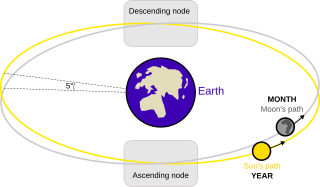
A lunar node is either of the two orbital nodes of the Moon, that is, the two points at which the orbit of the Moon intersects the ecliptic. The ascending node is where the Moon moves into the northern ecliptic hemisphere, while the descending node is where the Moon enters the southern ecliptic hemisphere.

Lunar precession is a term used for three different precession motions related to the Moon. First, it can refer to change in orientation of the lunar rotational axis with respect to a reference plane, following the normal rules of precession followed by spinning objects. In addition, the orbit of the Moon undergoes two important types of precessional motion: apsidal and nodal.
A geocentric orbit or Earth orbit involves any object orbiting Earth, such as the Moon or artificial satellites. In 1997, NASA estimated there were approximately 2,465 artificial satellite payloads orbiting Earth and 6,216 pieces of space debris as tracked by the Goddard Space Flight Center. More than 16,291 objects previously launched have undergone orbital decay and entered Earth's atmosphere.

Within the atmospheric sciences, atmospheric physics is the application of physics to the study of the atmosphere. Atmospheric physicists attempt to model Earth's atmosphere and the atmospheres of the other planets using fluid flow equations, chemical models, radiation budget, and energy transfer processes in the atmosphere. In order to model weather systems, atmospheric physicists employ elements of scattering theory, wave propagation models, cloud physics, statistical mechanics and spatial statistics which are highly mathematical and related to physics. It has close links to meteorology and climatology and also covers the design and construction of instruments for studying the atmosphere and the interpretation of the data they provide, including remote sensing instruments. At the dawn of the space age and the introduction of sounding rockets, aeronomy became a subdiscipline concerning the upper layers of the atmosphere, where dissociation and ionization are important.
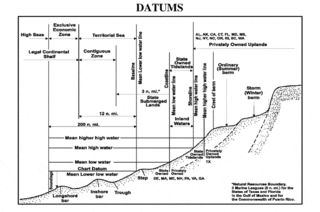
A chart datum is the water level surface serving as origin of depths displayed on a nautical chart. A chart datum is generally derived from some tidal phase, in which case it is also known as a tidal datum. Common chart datums are lowest astronomical tide (LAT) and mean lower low water (MLLW). In non-tidal areas, e.g. the Baltic Sea, mean sea level (MSL) is used. A chart datum is a type of vertical datum and must not be confused with the horizontal datum for the chart.

James O. Berkland was an American geologist who controversially claimed to be able to predict earthquakes, including the 1989 Loma Prieta earthquake and 1994 Northridge Earthquake and who popularized the idea that some people are earthquake sensitive. He was profiled in a popular 2006 book as The Man Who Predicts Earthquakes. The book includes a chapter that notes "Many of Berkland's theories--based on tides, moons, disoriented pets, lost cats and dogs, and magnetic field changes--were factors in the great Indian Ocean quake-tsunami disaster on December 26, 2004." but neither his methods nor his predictions have been published in any scientific journals for peer review. His results have been disputed by peers, with other scientists going so far as calling him a crank and a clown.
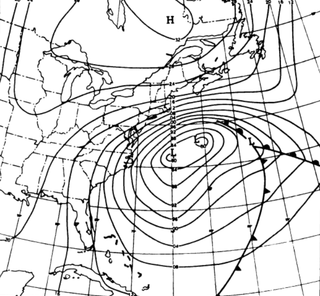
The Ash Wednesday Storm of 1962 occurred on March 5–9, 1962 along the mid-Atlantic coast of the United States. Also known as the Great March Storm of 1962, it was considered by the U.S. Geological Survey to be one of the most destructive storms ever to affect the mid-Atlantic states. Classified as a level 5 or Extreme Nor'easter by the Dolan-Davis scale for classification of Atlantic Nor'easters it was one of the ten worst storms in the United States in the 20th century. It lingered through five high tides over a three-day period, killing 40 people, injuring over 1,000, and causing hundreds of millions in property damage in six states. The storm also deposited significant snowfall over the Southeast, with a regional snowfall index of 12.663.
The Saxby Gale was a tropical cyclone which struck eastern Canada's Bay of Fundy region on the night of October 4–5, 1869. The storm was named for Lieutenant Stephen Martin Saxby, a naval instructor who, based on his astronomical studies, had predicted extremely high tides in the North Atlantic Ocean on October 1, 1869, which would produce storm surges in the event of a storm.
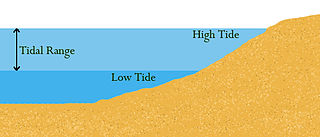
Tidal range is the difference in height between high tide and low tide. Tides are the rise and fall of sea levels caused by gravitational forces exerted by the Moon and Sun and by Earth's rotation. Tidal range depends on time and location.

The Moon orbits Earth in the prograde direction and completes one revolution relative to the Vernal Equinox and the stars in about 27.32 days and one revolution relative to the Sun in about 29.53 days. Earth and the Moon orbit about their barycentre, which lies about 4,670 km (2,900 mi) from Earth's centre, forming a satellite system called the Earth–Moon system. On average, the distance to the Moon is about 385,000 km (239,000 mi) from Earth's centre, which corresponds to about 60 Earth radii or 1.282 light-seconds.

The former Proudman Oceanographic Laboratory (POL) is based in Brownlow Street, Liverpool, England. In April 2010, POL merged with the National Oceanography Centre, Southampton (NOCS) to form the National Oceanography Centre. The Liverpool laboratory's scientific research focuses on oceanography encompassing global sea-levels and geodesy, numerical modelling of continental shelf seas and coastal sediment processes. This research alongside activities of surveying, monitoring, data management and forecasting provides strategic support for the wider mission of the Natural Environment Research Council.
Earth tide is the displacement of the solid earth's surface caused by the gravity of the Moon and Sun. Its main component has meter-level amplitude at periods of about 12 hours and longer. The largest body tide constituents are semi-diurnal, but there are also significant diurnal, semi-annual, and fortnightly contributions. Though the gravitational force causing earth tides and ocean tides is the same, the responses are quite different.
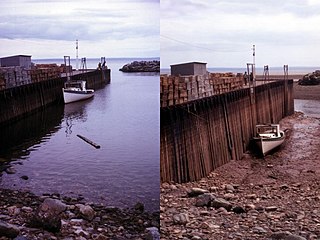
The theory of tides is the application of continuum mechanics to interpret and predict the tidal deformations of planetary and satellite bodies and their atmospheres and oceans under the gravitational loading of another astronomical body or bodies.

A king tide is an especially high spring tide, especially the perigean spring tides which occur three or four times a year. King tide is not a scientific term, nor is it used in a scientific context.

New Zealand has large ocean energy resources but does not yet generate any power from them. TVNZ reported in 2007 that over 20 wave and tidal power projects are currently under development. However, not a lot of public information is available about these projects. The Aotearoa Wave and Tidal Energy Association was established in 2006 to "promote the uptake of marine energy in New Zealand". According to their 10 February 2008 newsletter, they have 59 members. However, the association doesn't list its members.

A supermoon is a full moon or a new moon that nearly coincides with perigee—the closest that the Moon comes to the Earth in its elliptic orbit—resulting in a slightly larger-than-usual apparent size of the lunar disk as viewed from Earth. The technical name is a perigee syzygy or a fullMoon around perigee. Because the term supermoon is astrological in origin, it has no precise astronomical definition.

WT1190F was a small temporary satellite of Earth that impacted Earth on 13 November 2015 at 06:18:21.7 UTC. It is thought to have been space debris from the trans-lunar injection stage of the 1998 Lunar Prospector mission. It was first discovered on 18 February 2013 by the Catalina Sky Survey. It was then lost, and reacquired on 29 November 2013. It was again discovered on 3 October 2015 by astronomer Rose Garcia with the Catalina Sky Survey 60-inch telescope, and the object was soon identified to be the same as the two objects previously sighted by the team, who have been sharing their data through the International Astronomical Union's Minor Planet Center (MPC). An early orbit calculation showed that it was orbiting Earth in an extremely elliptical orbit, taking it from within the geosynchronous satellite ring to nearly twice the distance of the Moon. It was also probably the same object as 9U01FF6, another object on a similar orbit discovered on 26 October 2009.
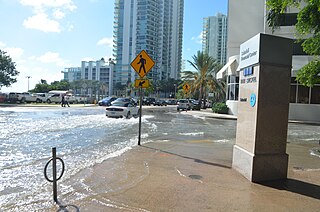
Tidal flooding, also known as sunny day flooding or nuisance flooding, is the temporary inundation of low-lying areas, especially streets, during exceptionally high tide events, such as at full and new moons. The highest tides of the year may be known as the king tide, with the month varying by location. These kinds of floods tend not to be a high risk to property or human safety, but further stress coastal infrastructure in low lying areas.
References
- Easterbrook, D.J. (1999). Surface Process and Landforms. 2nd ed. Upper Saddle River, NJ: Prentice Hall.
- Duxbury, A.B., Duxbury, A.C., Sverdrup, K.A. (2002). Fundamentals of Oceanography. 4th ed. New York, NY: McGraw Hill.
- http://co-ops.nos.noaa.gov/faq2.html#15 Archived 2008-05-13 at the Wayback Machine
- Wood, Fergus J. (2001). Tidal Dynamics Volume I: Theory and Analysis of Tidal Forces; Volume II Extreme Tidal Peaks and Coastal Flooding. 3rd ed. West Palm Beach, Fl: The Coastal Education and Research Foundation [CERF] ISBN 0-938415-10-7

